Section 3.1. Correction Basics
Let's start with a few basic philosophies for making corrections. (Note that many of these techniques apply to much more than color corrections.)
3.1.1. Using Layers to Make Corrections
The first thing I like to do when I make corrections is make a duplicate layer of the original image and assign the date or a descriptive name for the layer, such as "Color Correction." That way, there is no confusion as to when your work was done and what the layer is. This is especially helpful if you have many layers in your file. I find there is nothing worse than calling a layer its default name, like "Layer 0:"; this doesn't tell anyone anything about the layer. Another reason I make a copy of the layer is because if the client wants to go back to the original for any reason, I have it.
One more good reason for duplicating a layer is because it can be very easy to alter a change I have made to the image. If I have made a color change and the client finds that I haven't gone far enough with the change (or I have gone too far with the change), I can simply change the opacity of the corrected layer to get me where I want to go without having to start all over (Figure 3-1). It is very common for client to ask if I can go somewhere halfway in between two changes, if I have a layer with the change I have made, it is a simple matter of adjusting the opacity of the layer. A simple click on the layer opacity to 50%, and I'm halfway there! A very handy way to make quick adjustments.
Figure 3-1. Using layers to make multiple color changes to an image allows for easy adjustments to clients ' requests
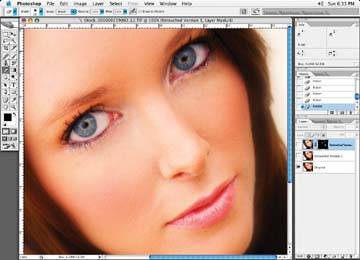
I may make adjustments to part of an image this way as well. Let's suppose the client loves the color change to one part of the image, but wants to go back to the original in another area of the image. I'd use a mask, a Pen toolcreated selection, a Lasso tool selection, or my Erase brush to eliminate what I don't want changed on my color-adjusted layer, as in Figure 3-2. A layer mask would work well in this situation as well.
Figure 3-2. Erase part of an image from a layer to let the bottom one show through
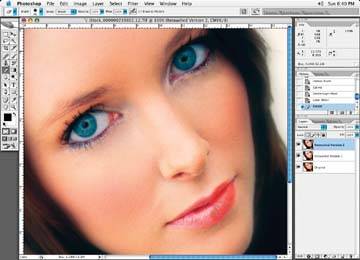
3.1.2. Correction Changes
Be careful not to overdo corrections. I can't count how many times I've seen corrections that have gone way too far and ended up looking unrealistic . Look at the front covers of magazines at the food store checkout shelves , and you can spot the overly white teeth, whites of eyes over corrected, the color of eyes emphasized beyond anything that exists in nature, and so on. Remember: the idea is to make corrections look as though the image has not been retouched. (I realize that some of these corrections are out of the retouchers' control if the client's wishes have been carried out as directed.)
One good option after a correction is made is to make use of the Fade (Apple/Option+F) command. The Fade command will allow you to adjust the intensity of a correction just after you make it. I have found this to be useful especially if you have a client who can't decide how far to go with a change. At least this way you can move the slider back and forth until you get an OK to the change without having to keep going back into a correction mode. The Fade dialog box is shown in Figure 3-3.
Note: One thing to keep in mind, if you are changing many images that require the exact same change, short of running a batch file, is to hold down the Option key while calling up your last color-correction adjustment. The last adjustment will be recalled when you hold down the Option keypretty handy when doing many images that require the same correction.
Figure 3-3. The Fade command dialog box
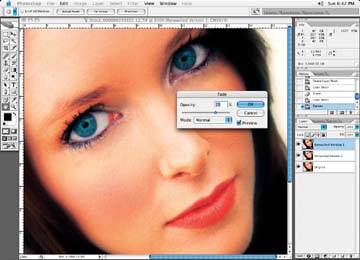
It is helpful to reduce the viewing size of the image you're correcting on screen so that you're looking at a size similar to the actual print size (Figure 3-4). Obviously, the size of your screen will dictate how large you can view an image on screen, but this gives a much better idea of how changes affect the image. It's easy enough to see changes at a very large size, but as dramatic as some of these changes may look when blown up on screen, their effect is usually greatly reduced when you see final output from a printer. Having said that, when I make a change at a small size on screen, I will check the image at a larger screen size to make sure the change I have made is as desired, and that nothing unexpected has happened .
Figure 3-4. View the image in actual size to get full effect or lack thereof

3.1.3. Making Corrections with the History Brush
When making corrections, I rely heavily on the History brush, my most often used correction tool. Many people seem puzzled that I use the History brush as often as I do as a correction tool. I try to use masking functions as little as possible because of time and the risk of the mask being the wrong size, shape, etc. With the History brush, I can make subtle changes and corrections easily without masking or selections, so that the corrections will appear far more natural in appearance.
I typically don't like to make a mask to restrict color corrections. There are a couple of reasons for this. For one thing, it takes time to create a mask with the Pen tool and, depending on the image or area being masked, it could be quite complex. Brushing a mask in the mask mode is time consuming as well. What if the mask or shape you create isn't the right size? Or the shape isn't quite right? Or the positioning is off? An "organic" shape such as the blush on a cheek is hard to define with a lasso. There are many variables that could go wrong when creating a mask to restrict a correction.
Admittedly, if the area to be corrected is a sharp, predefined shape, or is a very obvious area that could be masked or selected easily with a Masking tool, it could be worthwhile to make a mask, especially if there is the possibility that the image may come back for further correction in the same area. Care must be taken however when a mask is made that you soften the selection edge to match the general look of the rest of the image so that when the correction is done, it doesn't appear carved out (as in Figure 3-5) or obviously corrected, but rather has a natural effect like the image in Figure 3-6.
Figure 3-5. Before: using a mask to redden cheeks in a face creates an unnaturally hard edge

Figure 3-6. After: using the History brush can give a natural effect to the blush
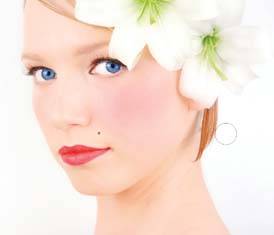
Let's suppose you have a person's face and you want to add a red blush to the cheeks. You could mask the area and use the Lasso tool and soften the selection, as in Figure 3-7. Or, you could use the Pen tool to create a shape and make a selection from that, or you could paint in a mask in the mask mode with a soft brush. Again, what if you don't like the position of the mask? Or the shape of the mask? Or maybe it's too hard or too soft? You'll have to spend time correcting the mask or selection when you could be doing the correction.
Figure 3-7. Even with a softer edge, the mask still looks unnatural
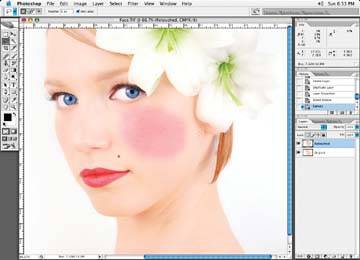
So let's use the History brush to add the blush to our original figure. First, make sure you do your correction on a duplicated layer of the layer to which you wish to make the correction. Start off by making an overall correction to the image, using the curves adjustment in the magenta channel, as you can see in Figure 3-8. Don't worry that we are making the correction to the whole image, as you will be taking a History snapshot of the correction and will be brushing in the correction only where it is needed. If I have had clients sitting behind me watching a History correction like this, panic usually sets in with them when they see the overall correction! Rest assured, their worries are put to rest when I explain what I am doing. The curve adjustment tool is under the menu item Images  Adjustments
Adjustments  Curves. Accept the change when you have the blush color you are looking for by clicking OK.
Curves. Accept the change when you have the blush color you are looking for by clicking OK.
Figure 3-8. A face with a curve adjustment in the magenta without a selection
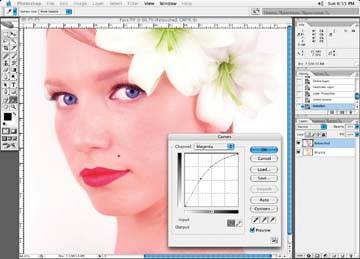
Obviously, the correction is applied to the whole face, which is not what I am looking for yet. Next, take a History snapshot of the correction and name it Red Cheek, as shown Figure 3-9. A History snapshot is taken by clicking on the little camera icon in the History palette. When you take a History snapshot, a new little image icon appears in the History palette list.
Figure 3-9. Save your snapshot by using the History palette tool

Next, undo your color correction so it reverts back to the original look of the image. Then select the History brush from the Tools palette. Be very sure that you click only the little checkbox to the left of the newly created History snapshot and not on the History snapshot icon itself. If you click on the History snapshot icon, you will change the whole image to the color change you just made, and you don't want that. If you do click on the History snapshot icon, simply go to your list of History palette states and click on the one prior to the correction you just made.
In the History brush attributes (Figure 3-10), select a brush size and softness you think will suit your task; in this case, we'd like to create a soft blush on this person's cheeks, so let's select a large brush that is very soft. I also set my brush opacity to about 20%, a good starting point.
Figure 3-10. History brush attributes
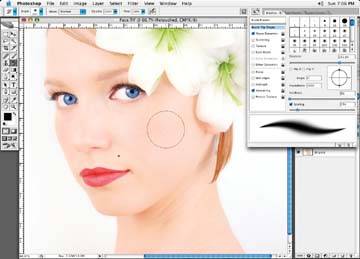
Next, click on the History snapshot you took earlier of the correction you had made. Be sure you don't click on the actual image portion of the snapshot or the whole image will change. Just click on the little eye to the left of the History snapshot. Now select the History brush from the Tool palette. Or use the Apple Y key to select it. Once thing to keep in mind with the History brush is that if you ever use the Undo key to revert a change, you will have to reselect the History snapshot from the History palette. If you think you may be making many History snapshot corrections, giving them a descriptive name may prove useful.
Note: One of the few things you cannot do with the History brush is change color modes and expect to brush in the change. The History brush will not allow you to brush in a change from another color mode. For instance, if you change the image to grayscale, and then back to the original color, you won't be able to brush in the grayscale mode information into the color image.
Go over to the image and begin to brush in your History snapshot of the color-corrected image onto the cheeks. Keep brushing until you achieve the look you're after. You can see the final effect in Figure 3-11.
As you can see on the final image, the changes are very natural and very little time was spent on this correction. The beauty of the History brush is that you are not limited to the type of correction you make. You can use any of the filters and color-correction tools available and apply them with the History brush. It wouldn't be uncommon for me to make several corrections to an image using various correction tools and complete the image without ever making a mask.
Figure 3-11. The final effect
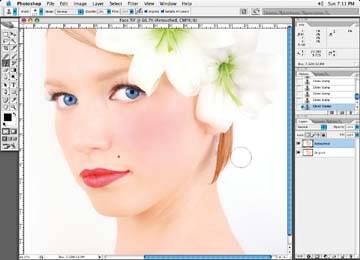
EAN: N/A
Pages: 83